Will Apple Vision Pro revolutionize the market?
First impressions after WWDC 2023
It has been a week since the Apple WWDC 2023 conference, where the highly anticipated Apple Vision Pro headset was unveiled.
Such an event could not go unnoticed. There has been a plethora of information from online creators, both those who had access to the showcase and testing of Apple Vision Pro, and those who simply follow technological advancements. AR, VR, and MR solutions have long found applications in various fields such as entertainment, training, design, production, medicine, and tourism.
Their usefulness and the interest surrounding them continue to grow, and Vision Pro could be a significant step towards greater popularization. We have gathered a wealth of available information for you and will share some insights from our perspective as a software house that deals with virtual and augmented reality technology on a daily basis.

Apple Vision Pro features: New operating system, rendering quality, and gesture support
During the presentation, Apple focused on working from home, productivity and entertainment, presenting the Vision Pro headset as a versatile and multifunctional tool that can replace traditional everyday devices such as TVs, tablets, and laptops. The device operates on the new VisionOS operating system, which is already being compared in terms of capabilities to iPadOS. The new system, specifically designed for Vision Pro, aims to enable the use of the headset as a substitute computer, eliminating the need to rely on the small screen of a phone or laptop.
Additionally, the Apple headset will have one feature that sets it apart from other VR goggles available on the market. It is the remarkable (according to testers) “Passthrough,” which simply allows users to look through the Vision Pro at the surrounding real and virtual space. The smooth transition between the two can be regulated using the well-known Apple consumer feature, the Digital Crown. Regarding hand and finger tracking, it is best to quote a statement from someone at uploadvr.com who had the opportunity to test it firsthand 🙂
“…This was a powerful moment, more powerful than any previous “first” I’d experienced in VR. I feel the need to reiterate. I was looking at my own hands reconstructed by a headset’s sensors and it felt as if I was looking at them directly… Vision Pro did this right out of the gate for the first time in VR hardware. It worked so well that I question how transparent optics, like those in use by HoloLens 2 or Magic Leap 2, will ever hope to match Apple’s version of passthrough augmented reality in an opaque headset…”
The windows displayed inside the headset will have a 4K resolution, and the implemented Eye-Tracking technology will ensure that only the elements we are currently looking at are fully rendered. This will relieve the processor and extend battery life. According to individuals who had the opportunity to test the new headset, the reduced rendering quality of elements not currently being viewed is unnoticeable. This is influenced by the 12 mounted cameras, with a delay of only 12ms, which ensures smooth and fast usage. For comparison, the delay in the latest competitive MR headset from Meta (Quest Pro) ranges from 35 to 60ms.
One significant difference between Apple goggles and all other VR and MR goggles is the absence of controllers for their operation. This is not a matter of additional accessories, they simply do not exist. The entire device is operated using hand gestures, eye movements, and voice commands. This is made possible by the aforementioned cameras and 6 microphones. The cameras will track everything in our environment using LiDAR and TrueDepth sensors, as well as our eye movements.

So how will we select an application? Simply look at it and perform a simple finger gesture. Scrolling through applications? Look and perform a simple scrolling gesture. Sounds easy.
Apple has always been known for the ecosystem they created. During the presentation, a user wearing Vision Pro opened their MacBook and, while looking at its screen, saw the image transferred from the device’s screen to the goggles right in the second.
Technological advancements have continually accustomed us to virtual avatars. Last year, Meta showcased the creation of avatars using a phone and “Sociopticon” with 220 high-resolution cameras. The avatar creation process itself took several hours, and the processing time extended to even weeks. In the case of Apple, our virtual counterpart is created instantly by taking off the goggles and scanning the user’s face using the front-facing cameras on the device. Testers who examined their functionality reported that interacting with the virtual avatar exceeded the limits of naturalness. They felt as if they were genuinely talking to a real person who looked them in the eye, gestured, and displayed facial expressions like a real conversation partner. Does this mean the possibility of having conversations with people thousands of kilometers away while feeling as if we are sitting in the same room? It is highly possible.

Technical Specifications
It is also worth mentioning the technical specifications, which are presented in the table below. The goggles have been directly compared to the Quest Pro headset.
Despite being only 2 years older, the Vision Pro competitor falls significantly behind. However, let’s not forget that the Meta headset supports virtual reality technology and is operated using hand-tracking and controllers. Despite the differences, it currently has a wider range of applications than the newly introduced Apple device. Although with the current pace of technological development, this could change rapidly. The Vision Pro is the first generation product from the American giant, while Meta already has, among others, Quest 1, 2, and the announced version 3 in its portfolio.

Ecosystem, integrated apps, and future perspectives
Currently, there are no available applications to download from the system’s App Store on Apple Vision Pro. It can be said that history is repeating itself, similar to the release of the first iPhone, which also did not have an app store initially. However, this did not hinder its success, and we can see the effects of that decision even today. During the presentation, only pre-installed system applications perfectly tailored for VisionOS were showcased. The official release is still less than a year away, and there may be many changes ahead, which we will be closely following.
As demonstrated in the presentation, users utilized the headset not only for work but also extensively for entertainment purposes. Apple is just entering the market of AR, VR, and MR solutions, and the library of applications and solutions specifically designed for VisionOS is still being developed. What does this mean? It presents a significant opportunity for developers to create content that future users will benefit from. During the Apple conference, the specifications were made available for developers to start building applications. Additionally, it was announced that Vision Pro will fully support Unity, one of the world’s most popular game and application development engines.
People have long been using AR, VR, and MR headsets for watching movies, TV shows, and sports events, and they will continue to do so. One of the leading independent creators of technology-related content, Marques Brownlee, stated during testing that the things he tried on Vision Pro were the best he had ever seen in any VR or AR headset, particularly in terms of user interaction with the device.

In summary, revolution or evolution?
Apple Vision Pro headset have the potential and predisposition to change the technology market. Apple has already demonstrated this by popularizing its previous devices worldwide, such as the iPod (2001), iPhone (2007), iPad (2010), Apple Watch (2015), and AirPods (2016). Will it be a revolution or more of an evolution? We will find out in the future unless we use the term “revolution” in terms of popularizing this type of headset worldwide. In that case, it can confidently be stated that it will indeed be a revolution.
This is only the first generation, and its announced price for the US market is not among the lowest ($3499). The price for Europe will only be known closer to the release date in 2024. Nevertheless, this will compel the competition to continuously improve their products to retain customers or seek alternatives through aggressive pricing policies. A more comprehensive assessment of Apple Vision Pro will only be possible after its official debut or wider availability for testers and users. Personally, we can’t wait to start developing applications and games for Vision Pro, which will undoubtedly happen in the future. 🙂
What about you? What’s your opinion on this matter?


